Moroccan style invites you to blend centuries-old artistry with carefree boho spirit, turning an ordinary living room into a sun-kissed sanctuary layered in color, craft, and comfort. Bold jewel tones, tactile textiles, and handmade finishes anchor the look, while plant life and vintage treasures keep it feeling relaxed and personal. Interior designers stress balance: curate, don’t clutter, and let every pattern or patina earn its place. When done thoughtfully, the result feels collected over time—an oasis that glows by lamplight and sparks conversation by day. Ready to set that mood? Explore the ideas below and watch your own space come alive.
1. Saturate Walls in Jewel-Tone Neutrals
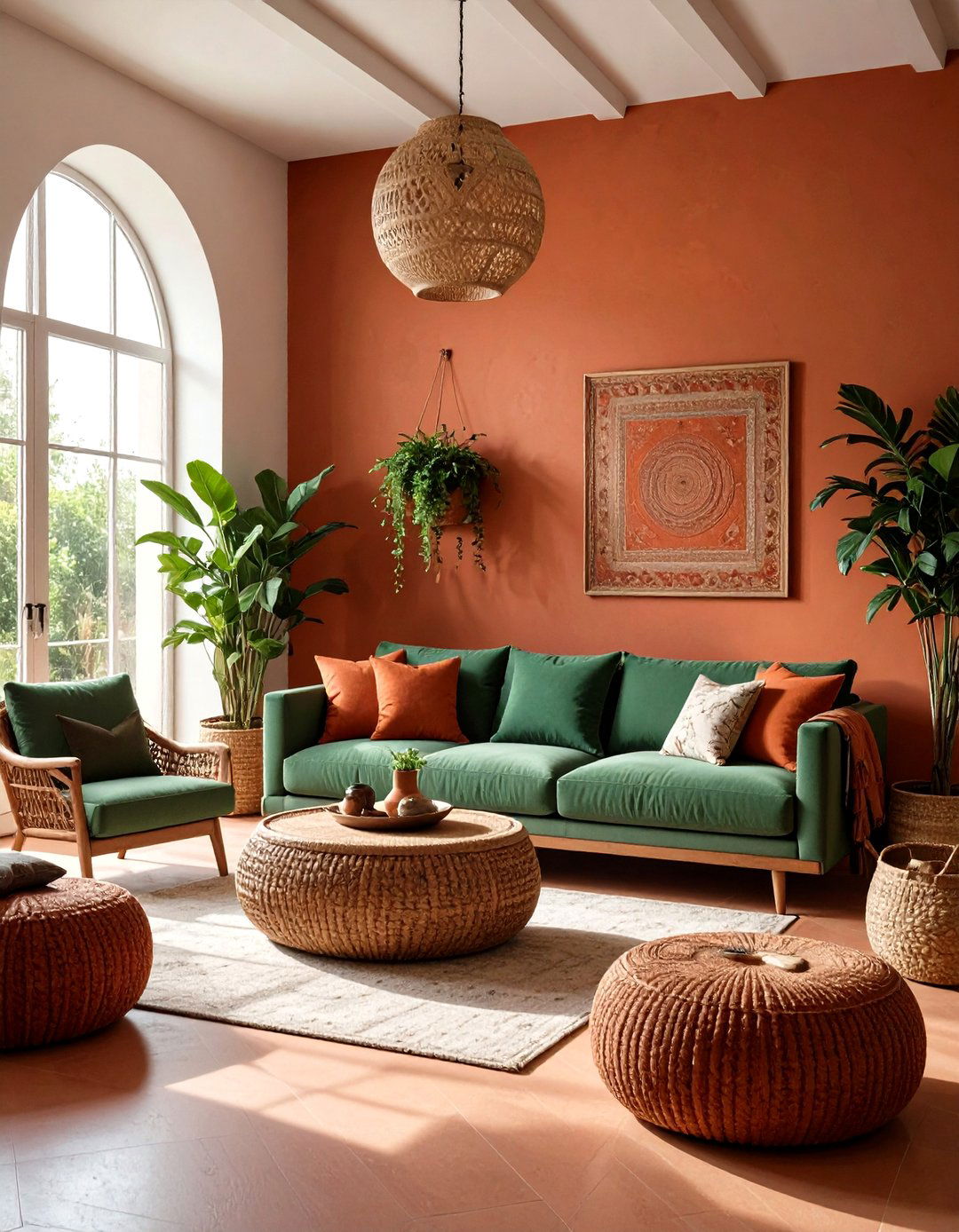
A whisper of terracotta or warm sand on the walls instantly grounds a Bohemian Moroccan living room, giving vivid accents room to shine. Designers recommend earthy background hues—think burnished clay, soft beige, and weathered ochre—because they echo Moroccan plaster and temper brighter textiles without dulling their impact. Layer these neutrals with flashes of emerald, saffron, or ruby in cushions and art to mimic the lively palette of Marrakech’s souks. This backdrop lets you swap accessories seasonally while maintaining harmony and avoiding the visual overload that can plague eclectic interiors.
2. Roll Out a Beni Ourain Rug—Then Layer Another
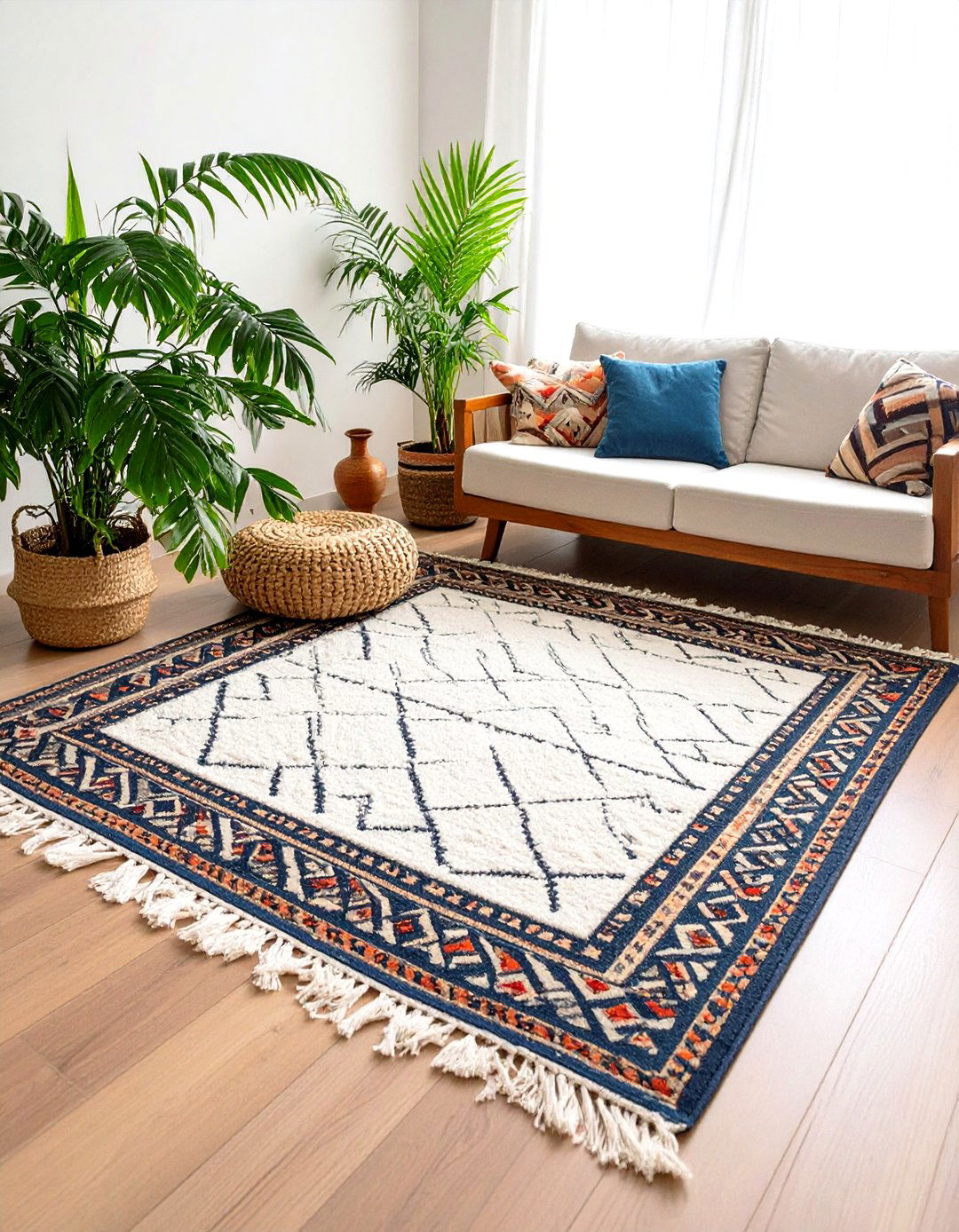
Unlike a single area rug, overlapping a plush Beni Ourain with a flatter vintage Kilim creates irresistible depth underfoot. The Berber-woven diamonds read as a modern neutral, while the Kilim’s saturated stripes deliver boho energy, anchoring the living room’s conversation zone. Designers love this pairing because the lofty wool softens acoustics and the kilim’s tighter weave resists daily traffic, so the combo is durable as well as dramatic. Angle the top rug or let edges peek asymmetrically to keep the arrangement from feeling staged.
3. Drape a Handira Wedding Blanket for Luminous Texture

Take any plain armchair or sofa and toss a silvery Handira across the back: suddenly the whole Moroccan living room twinkles. Woven by Berber brides, these ivory throws shimmer with rows of metal sequins that catch candlelight like tiny mirrors, adding subtle glam without relying on metallic furniture. Pair their nubby wool with linen or velvet pillows so the mix feels intentional, not haphazard. Because Handiras are relatively narrow, they’re also ideal runners across bench seating or the foot of a daybed when you crave sparkle elsewhere.
4. Cluster Brass Lanterns at Varying Heights

For, arguably, the most atmospheric lighting in a Bohemian Moroccan living room, suspend pierced-metal lanterns at staggered drops and let their cut-out patterns dance across walls. Brass warms the palette and patinas gracefully over years. Mixing bulb temperatures—soft white in one, amber in another—creates layers of glow that feel like flickering candles minus the fire risk. Designers suggest hanging them in odd numbers (three or five) to mirror the “rule of threes” used in plant styling, ensuring an organic rhythm overhead.
5. Build a Low-Slung Banquette Wrapped in Pillows

A, long wall-to-wall bench piled with oversized cushions channels the convivial seating of a traditional Moroccan salon while freeing up floor space. Upholster the base in hard-wearing canvas or leather, then load on pillows in mixed scales: 20-inch squares anchor the back, lumbar rolls add support, and tiny tasselled covers supply detail. This flexible layout lets guests scoot close for board games or sprawl for movie nights, embodying the free-spirited heart of boho design.
6. Spotlight a Zellige-Top Coffee Table
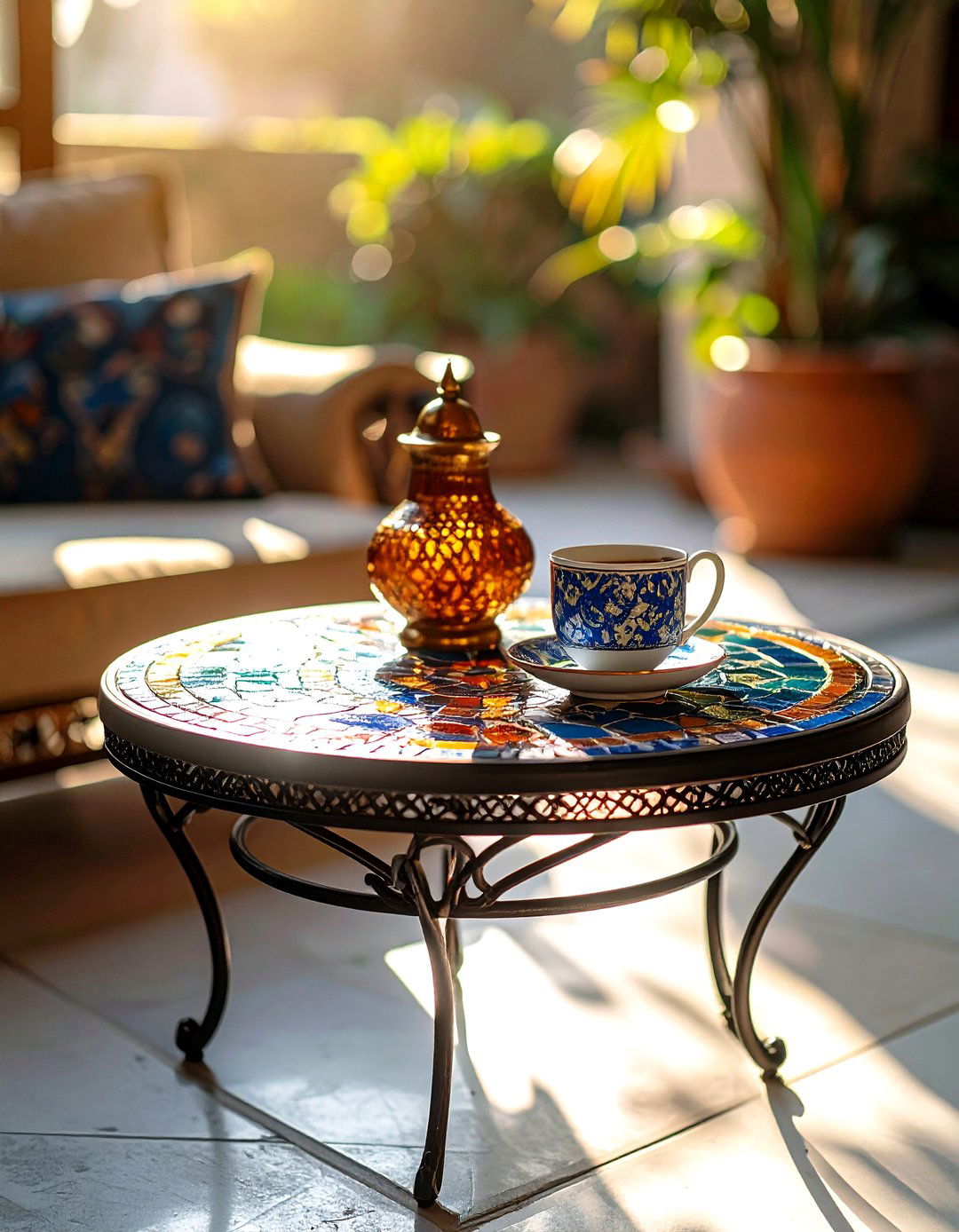
This, glossy mosaic instantly becomes the living room’s jewelry. Hand-cut zellige tiles vary in tone, so even a single-color top sparkles like water when sunlight hits. Pair the artisanal surface with a minimal iron base to keep the focus on the craftsmanship. Because the tiles are fired at high heat, they shrug off hot teacups and condensation, making the table as practical as it is pretty. To echo the motif subtly, repeat one tile hue on a nearby candle or planter.
7. Create Subtle Drama with a Tadelakt Accent Wall
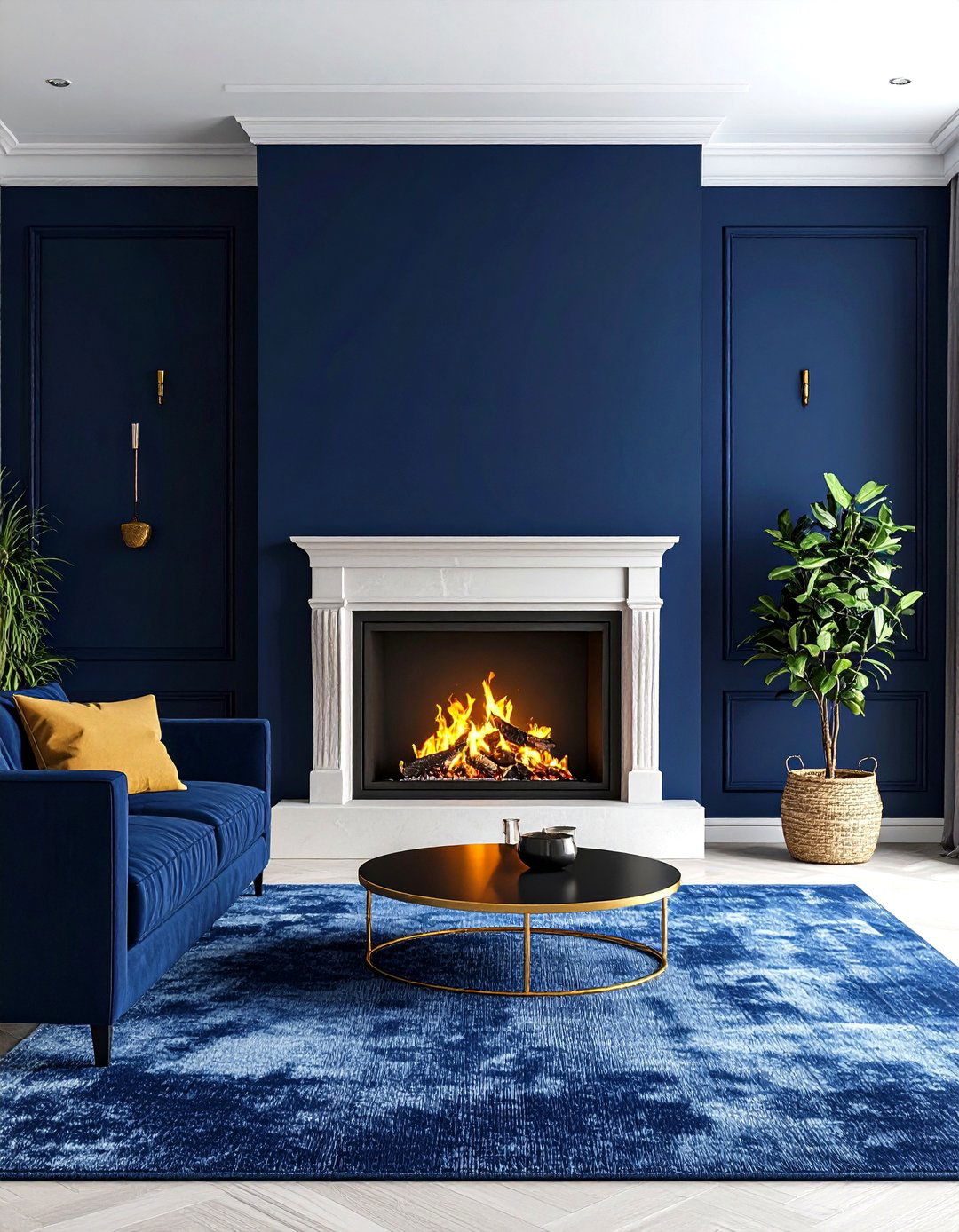
Certainly, nothing says Moroccan craftsmanship like velvety-matte tadelakt plaster. Applied in thin layers and burnished with black soap, the finish reads like stone yet feels silky, giving a Bohemian Moroccan living room quiet luxury without resorting to paint effects. Its light-absorbing surface enriches saturated wall colors—especially clay reds or deep blues—and resists everyday scuffs. Use it behind a fireplace, TV niche, or built-in shelving so its hand-troweled movement stays in the spotlight.
8. Divide Space with a Mashrabiya Screen
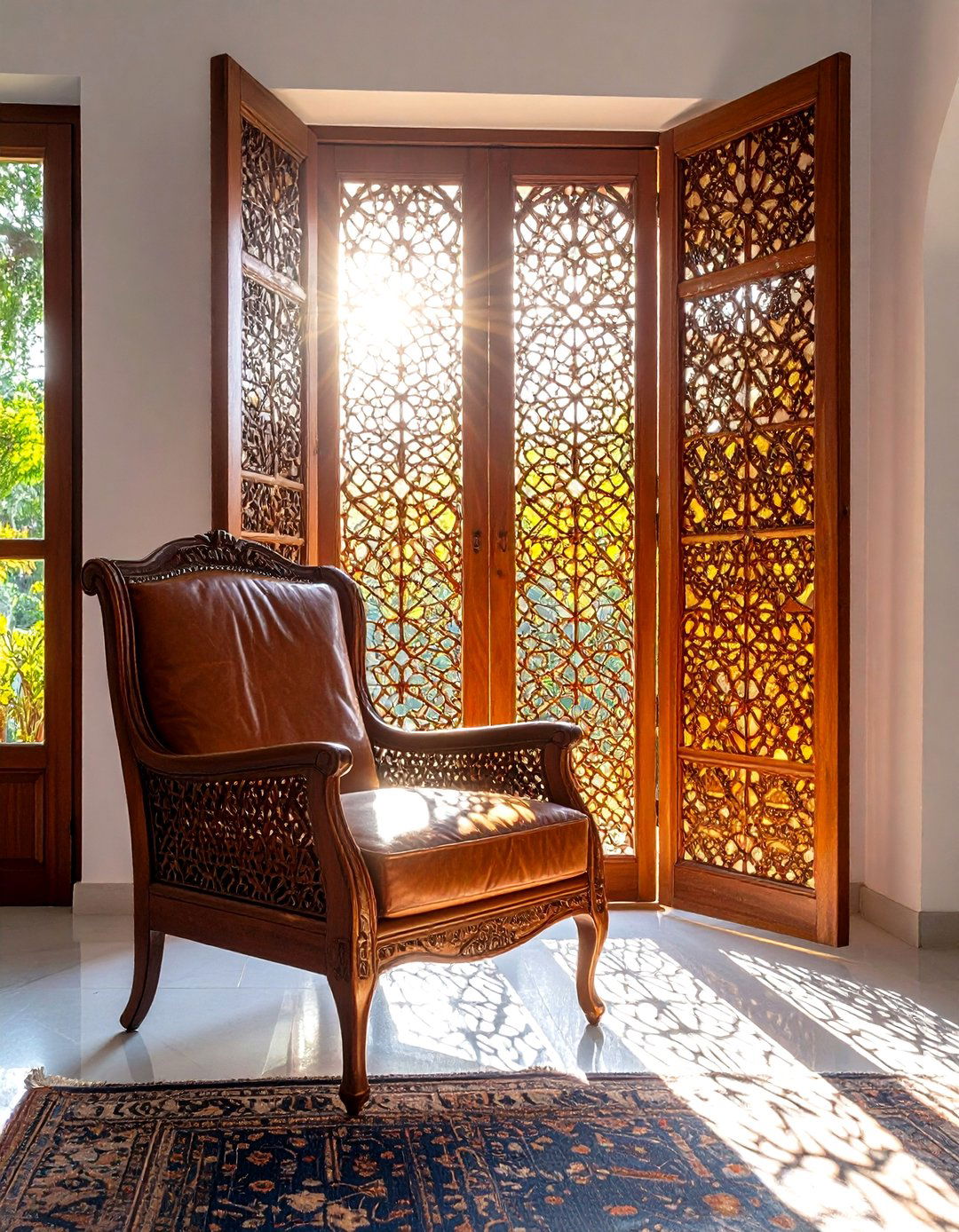
Consider carving zones in an open-plan living room by unfolding a hand-carved mashrabiya partition. The latticework filters light into lace-like shadows, adding privacy without blocking breezes or conversation. Because most panels hinge, you can flex the divider to corral a reading nook today and flatten it against a wall tomorrow. Stain it chestnut to complement vintage leather or paint it chalk-white for modern contrast—either way, the piece doubles as art.
9. Scatter Leather Poufs and Kilim Ottomans
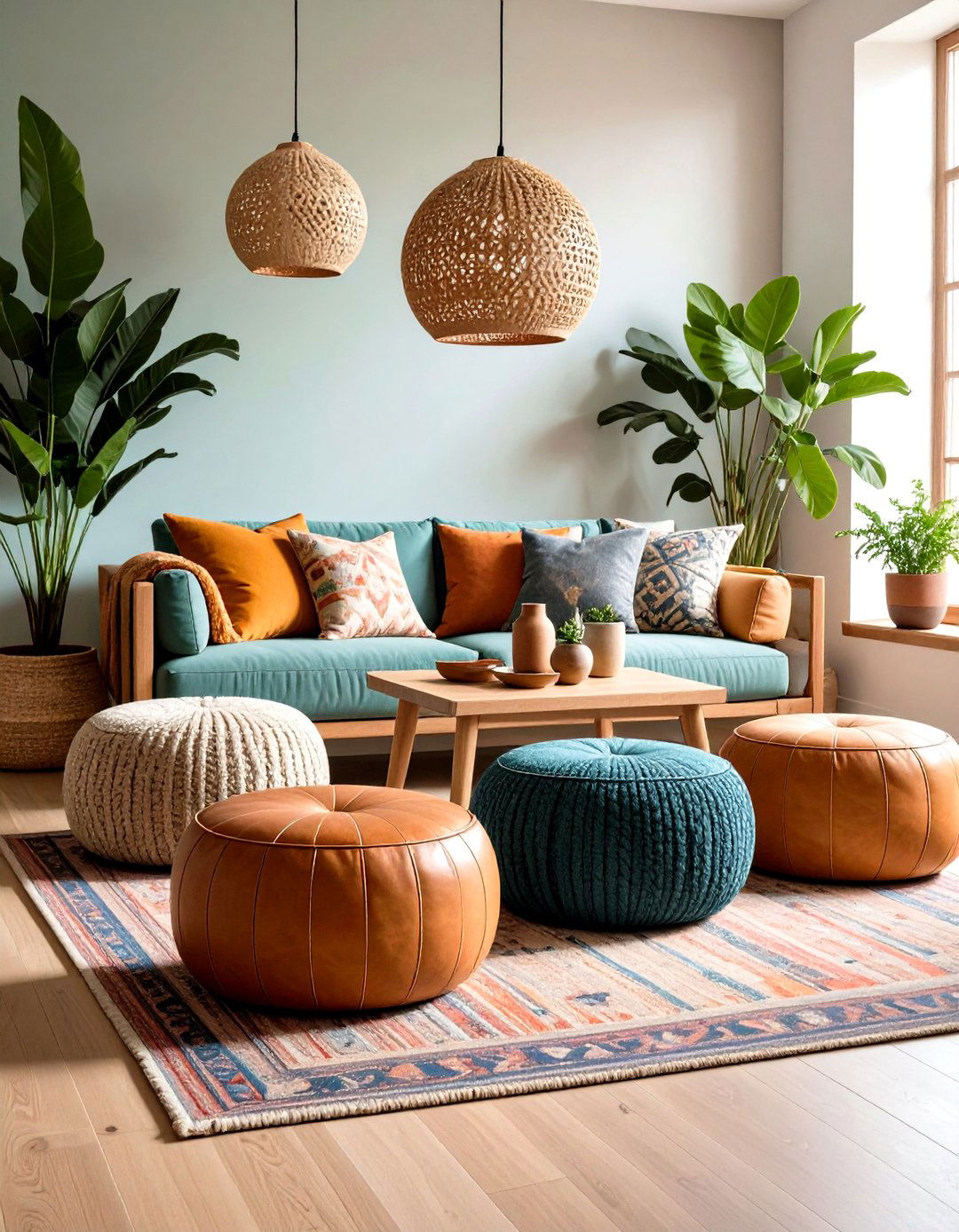
Looking for seating that’s both functional and sculptural? Round leather poufs and boxed kilim ottomans tuck under tables yet pop out for gatherings, embodying the informal ease of Bohemian Moroccan living rooms. Fill them firmly so they moonlight as footstools or side tables, then mix earth-toned leather with patterned textiles for variety. Because kids gravitate toward floor-level furniture, poufs keep delicate armchairs safe during playdates, too.
10. Splash on Majorelle Blue in a Single Stroke
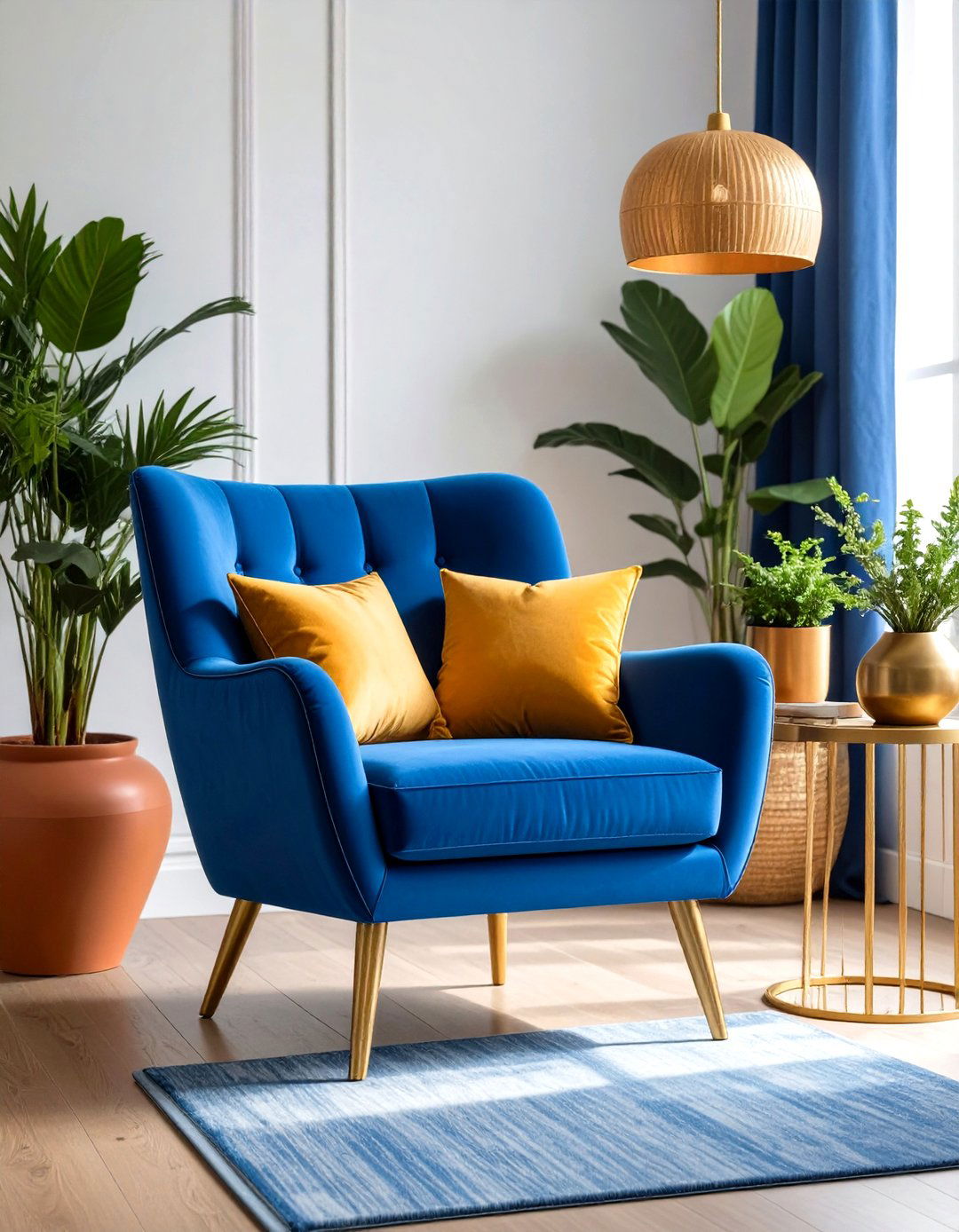
Surprisingly, one vivid swath of Majorelle Blue—be it an accent chair, a doorway arch, or a floating shelf—can electrify an otherwise neutral living room. The hue, made famous by Yves Saint Laurent’s Marrakech garden, pairs strikingly with brass and terracotta. Keep surrounding décor minimal so the color sings rather than shouts; even a trio of cobalt-rimmed pottery can echo the statement without tipping into kitsch.
11. Style Metal Trays for Everyday Ceremony

Unlike fragile glass, hammered brass trays withstand daily tea service and double as chic catch-alls. Rest one on the zellige table stocked with mint-tea glasses, then rotate it onto an ottoman when you need an impromptu surface. The reflective metal bounces candlelight at night, amplifying ambiance. Collect trays in different diameters and hang surplus pieces on the wall as functional art when not in use.
12. Grow an Indoor Oasis with Statement Plants
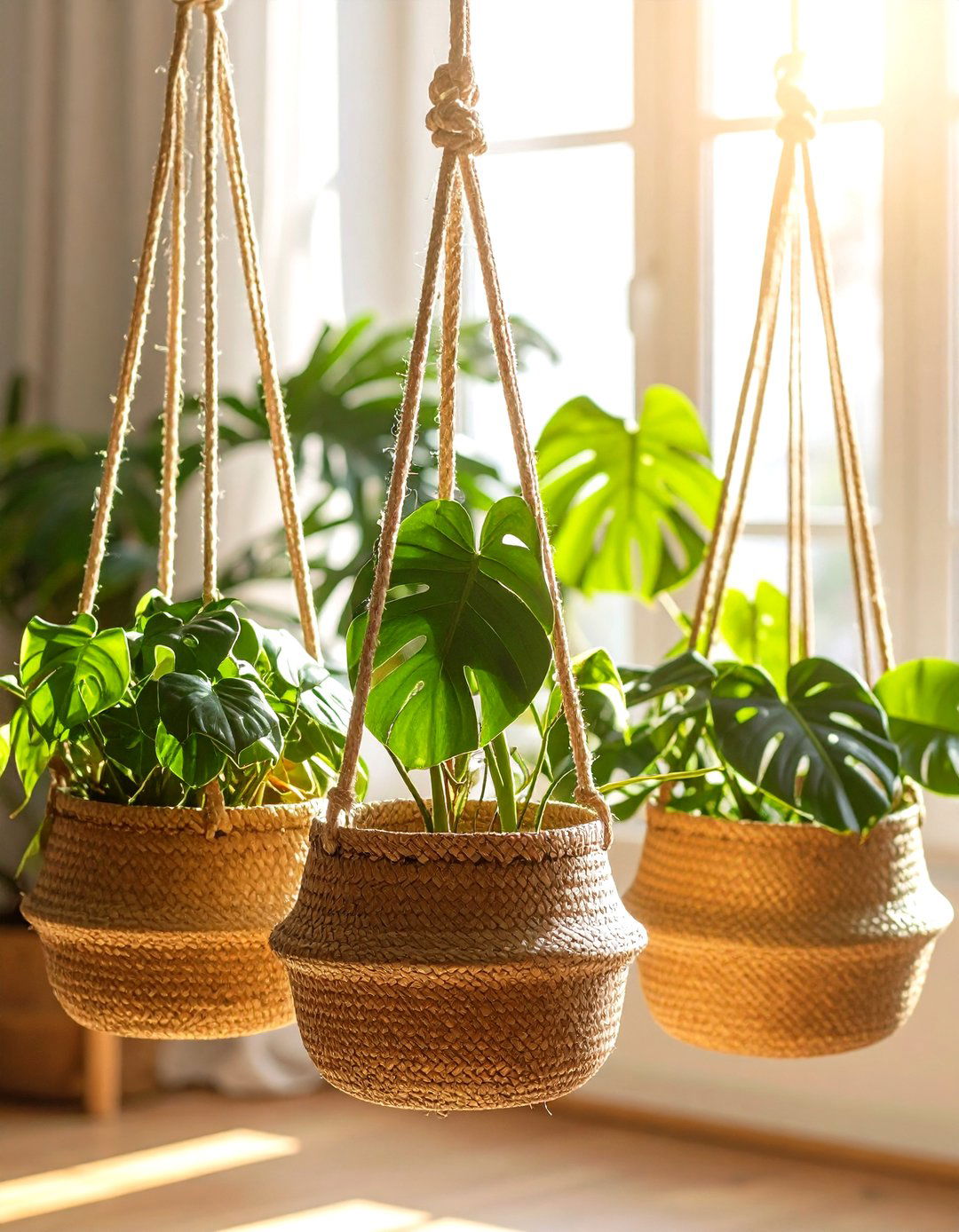
With lush leaves spilling from woven baskets, large houseplants soften the geometric patterns common in Moroccan textiles and provide that lived-in boho vibe. Monstera, snake plant, and ZZ thrive in typical living-room light and require minimal fuss. Group plants in odd numbers and stagger heights on stools or macramé hangers to mimic a courtyard garden. The greenery purifies air while visually cooling the room’s warm palette of reds and golds.
13. Hang Macramé for Soft, Vertical Texture
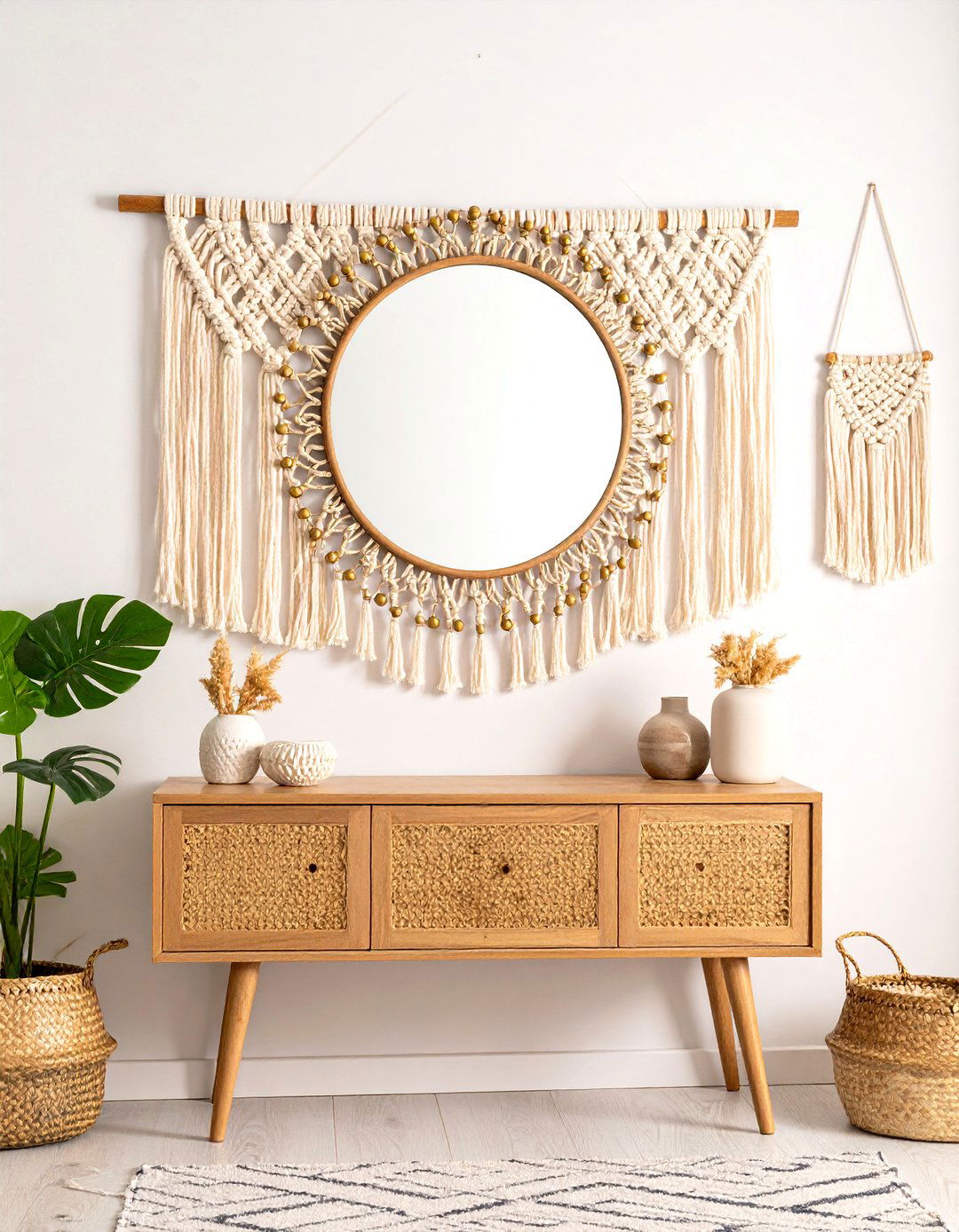
Bringing tactile art onto blank walls prevents a Bohemian Moroccan living room from feeling bottom-heavy with textiles only at sofa level. Opt for a cream macramé panel trimmed in brass beads to nod subtly to Moroccan metals. Its hand-knotted cords cast gentle shadows that echo lantern patterns, tying disparate elements together. Try layering a small round mirror at the center for depth and a hint of shine.
14. Layer Lighting with Sculptural Wall Sconces
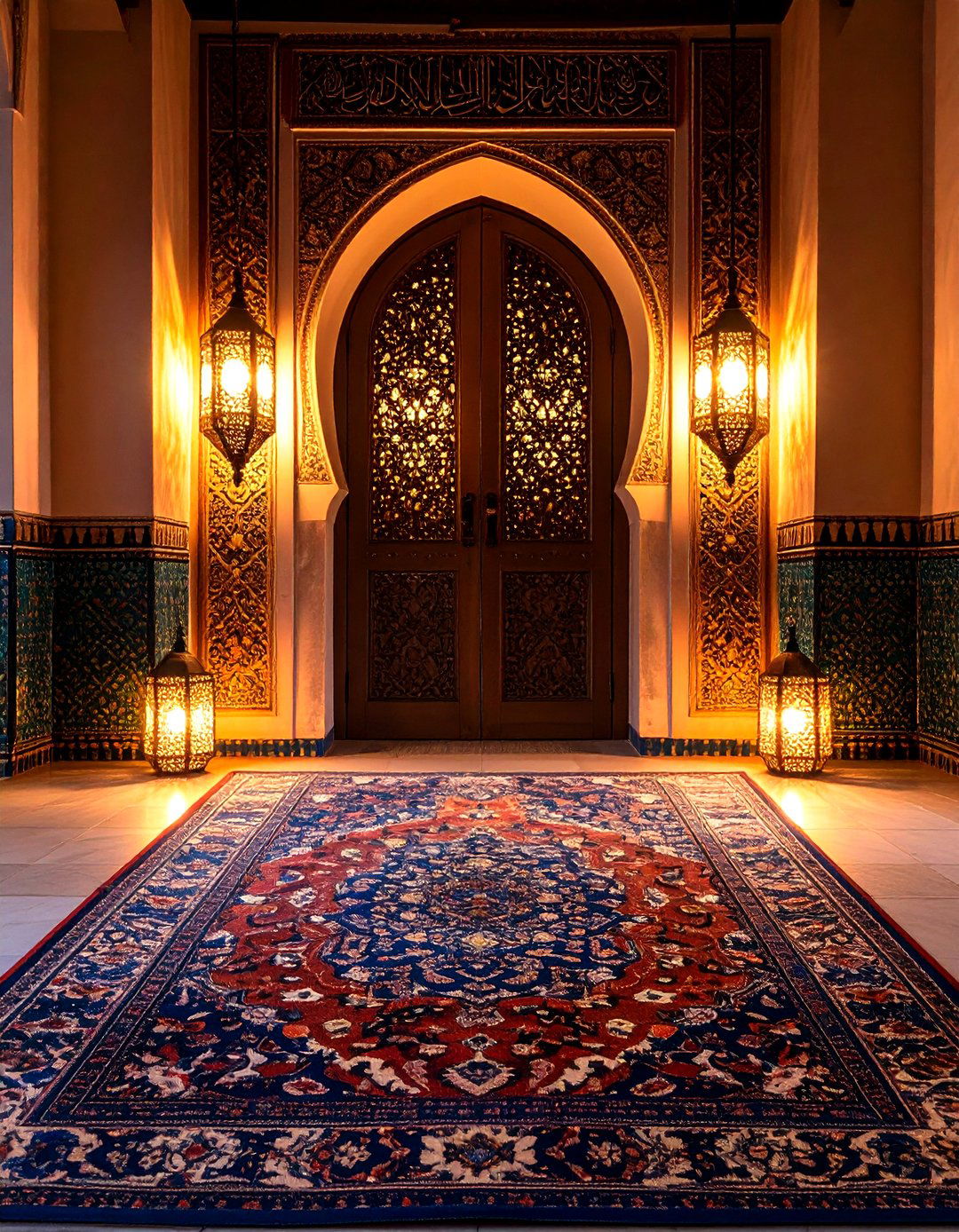
To wrap things up at twilight, add Moroccan-patterned brass sconces that throw filigree shadows and free tabletops from bulky lamps. Choose hard-wired fixtures for a polished look or plug-in models if you rent. Pair dimmable bulbs with the lantern cluster overhead so you can shift from bright gatherings to moody movie nights in seconds.
15. Display Berber Symbols as Gallery Art
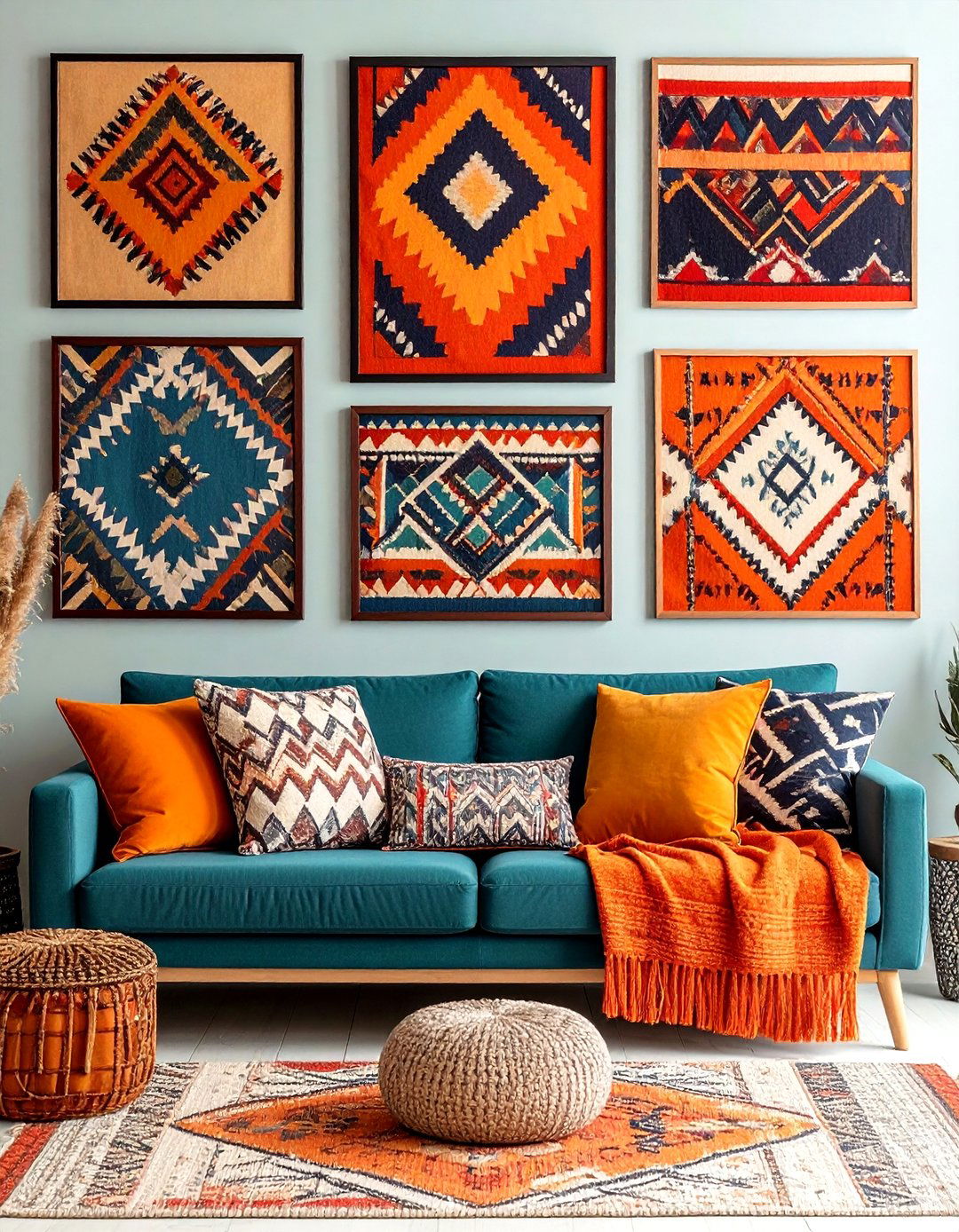
Studies of Berber weaving reveal protective motifs—diamonds for eye imagery, zigzags for water, and X-shapes for female energy. Framing fragments of vintage textiles or printing enlarged rug patterns on canvas lets these cultural stories inhabit your living room walls. Keep matting simple so the symbols remain star of the show, and scatter smaller accents—like embroidered pillows—elsewhere to reinforce the narrative.
16. Pile On Tasselled and Pompom Pillows
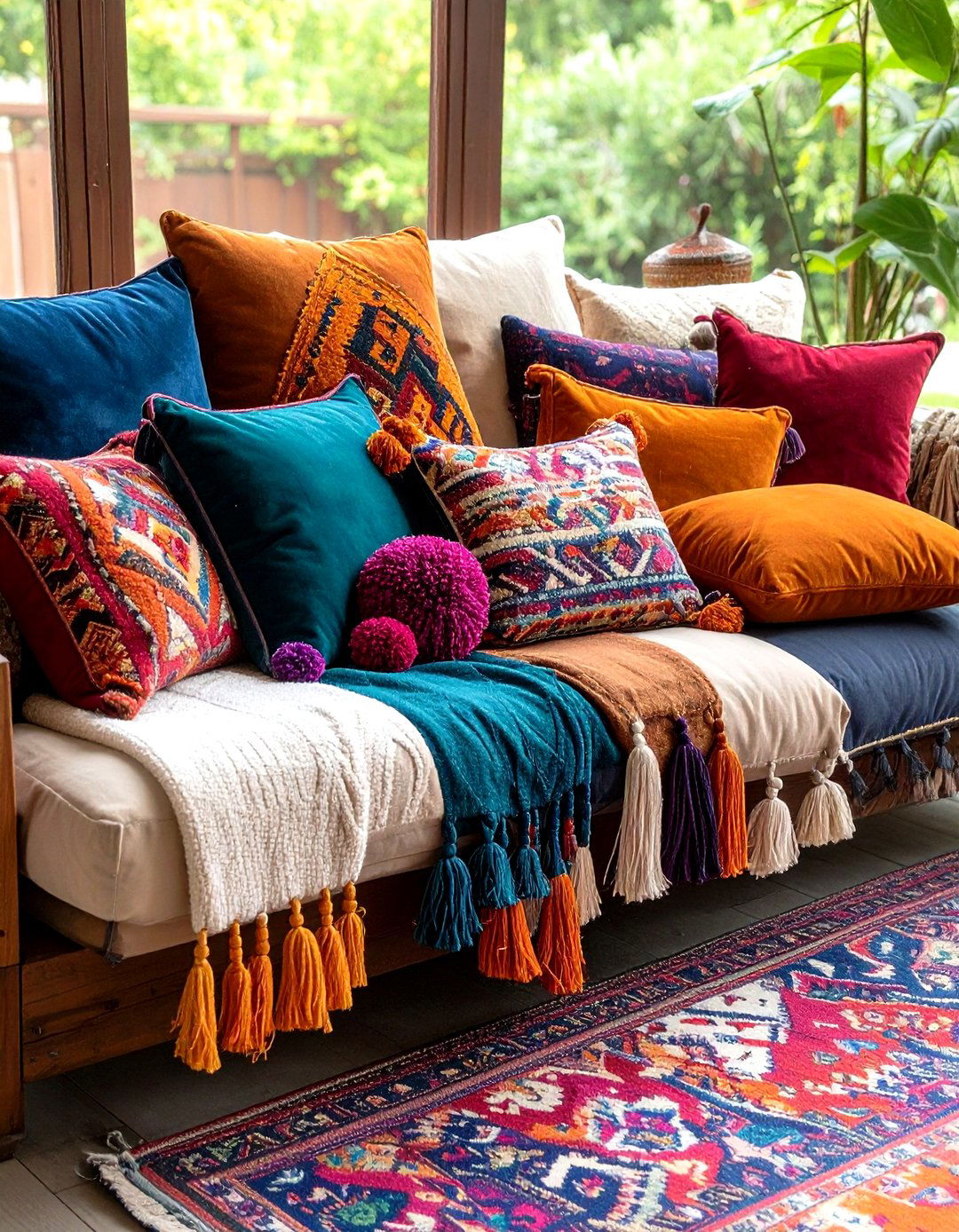
By peppering a sofa with fringe-trimmed pillows in multiple textures—velvet, mud cloth, and hand-loomed cotton—you underscore the laid-back eclecticism of a Bohemian Moroccan living room. Tassels invite touch, encouraging guests to cozy up, while pompoms lend whimsy that balances the gravitas of carved wood or brass. Keep a coherent palette (three to four colors max) to avoid chaos.
17. Energize the Ceiling with Hand-Painted Motifs
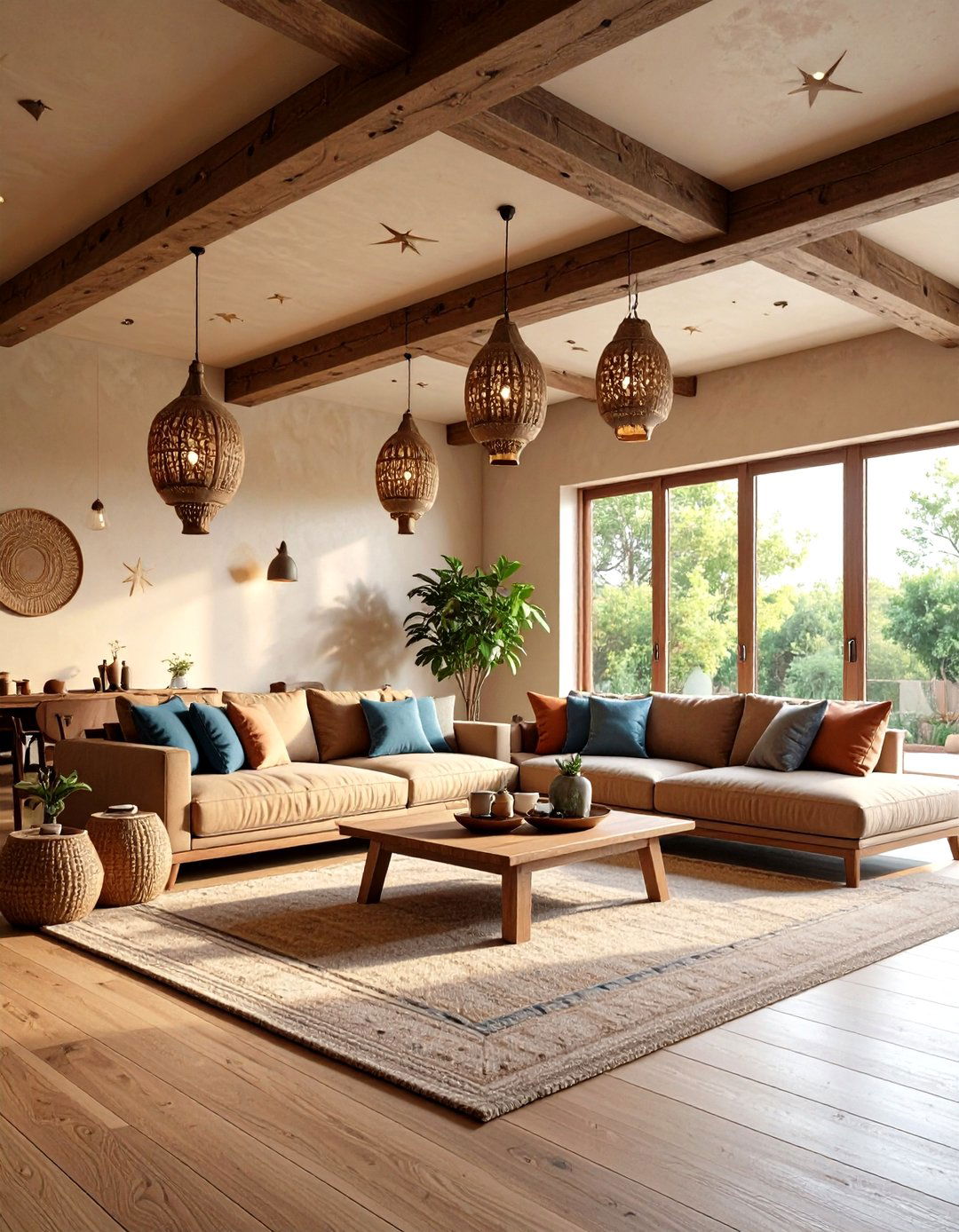
Despite being overlooked, the fifth wall offers prime real estate for Moroccan flourishes. Stenciled star patterns in muted clay paint overhead echo courtyard ceilings without the cost of carved cedar. The treatment draws eyes upward, making low rooms feel taller, and pairs beautifully with the lantern glow after dark. Opt for mineral paints that allow subtle brush variation for artisanal charm.
18. Showcase Terracotta and Clay Pottery
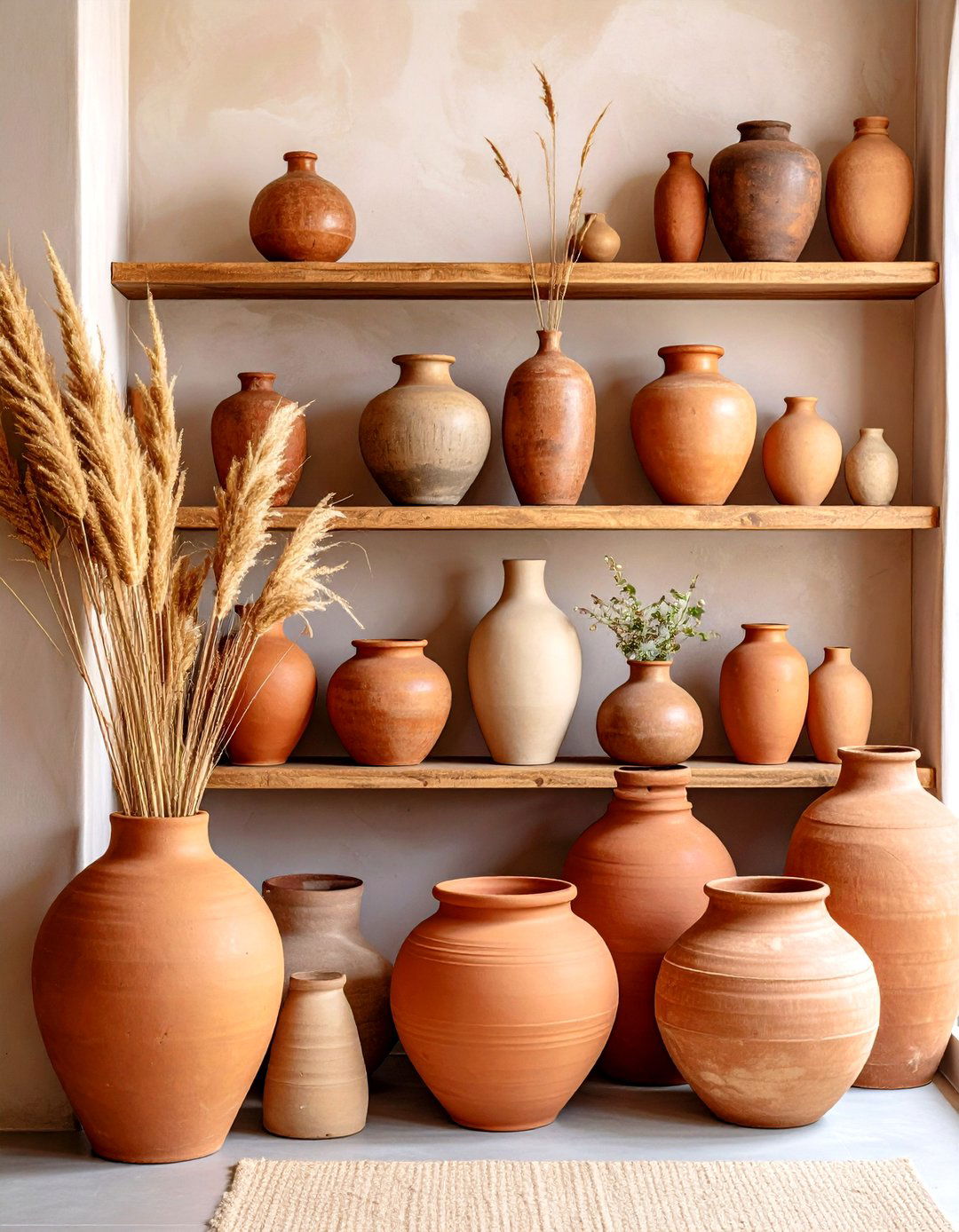
Owing to their organic curves and sun-baked hues, Moroccan clay pots temper the shimmer of metals and mosaics in a living room. Use oversized floor vessels to flank a sofa or perch smaller vases on shelving for height variation. Their matte finish contrasts glossy zellige, keeping surfaces visually engaging. Fill pots with dried grasses for texture that lasts all season.
19. Mix in Vintage Market Treasures
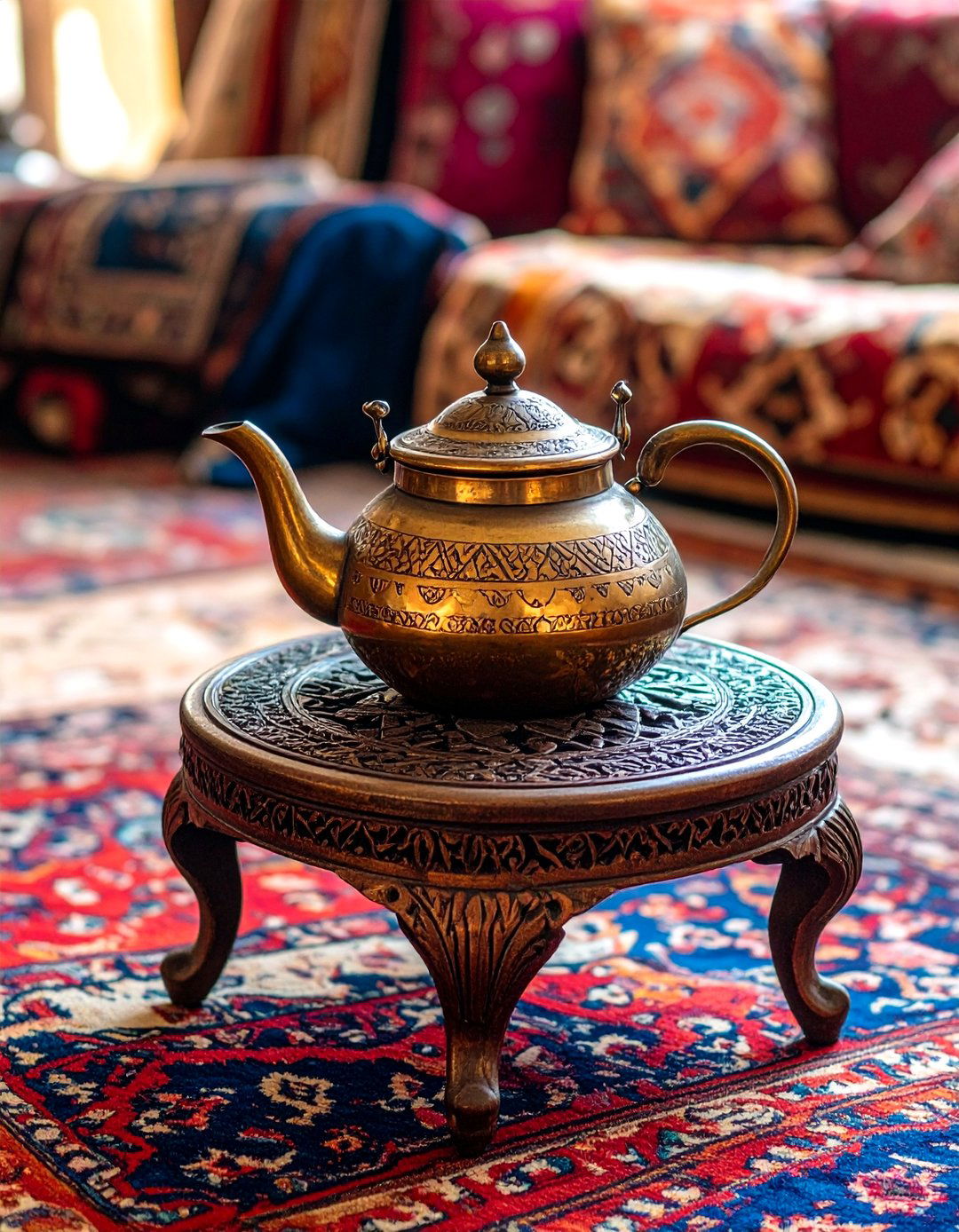
Certainly, no Bohemian Moroccan living room feels complete without a few storied pieces: maybe a time-worn brass teapot, a threadbare Azilal rug, or a carved cedar stool scored at a flea market. Vintage finds inject patina you can’t fake and serve as conversation catalysts. Follow designers’ advice to curate within a cohesive color story so cherished collectibles feel intentional, not random.
20. Keep Cohesion with a Curated Color Story
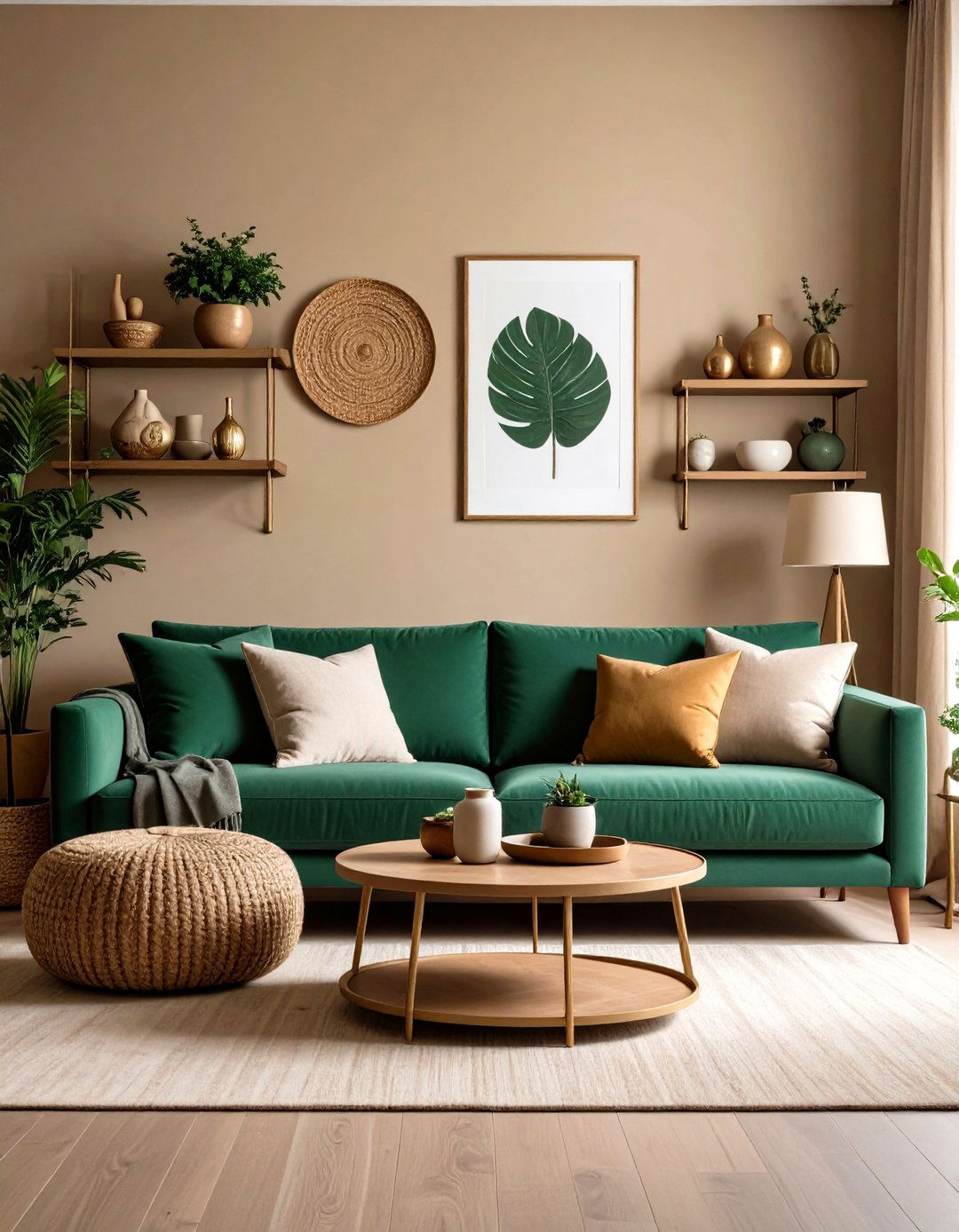
Finally, tie every woven throw, tile flash, and plant leaf back to three anchor shades—one dominant neutral, one bold accent, and one metallic. This restriction liberates rather than limits, letting you experiment with pattern scale and texture while sidestepping clutter. Designers note that a thoughtful palette lets the richness of Moroccan craftsmanship breathe, ensuring the living room remains inviting rather than overwhelming.
Conclusion:
A Bohemian Moroccan living room blossoms when handmade artistry meets mindful editing. Jewel-tone walls, layered rugs, gleaming lanterns, plant life, and tactile finishes weave a story of wanderlust without sacrificing everyday comfort. Curate objects within a consistent palette, embrace materials that age gracefully, and balance high-energy patterns with calming neutrals. The result is a living room that feels as soulful as a riad courtyard yet perfectly suited for modern lounging—proof that thoughtful design is the ultimate kind of hospitality.



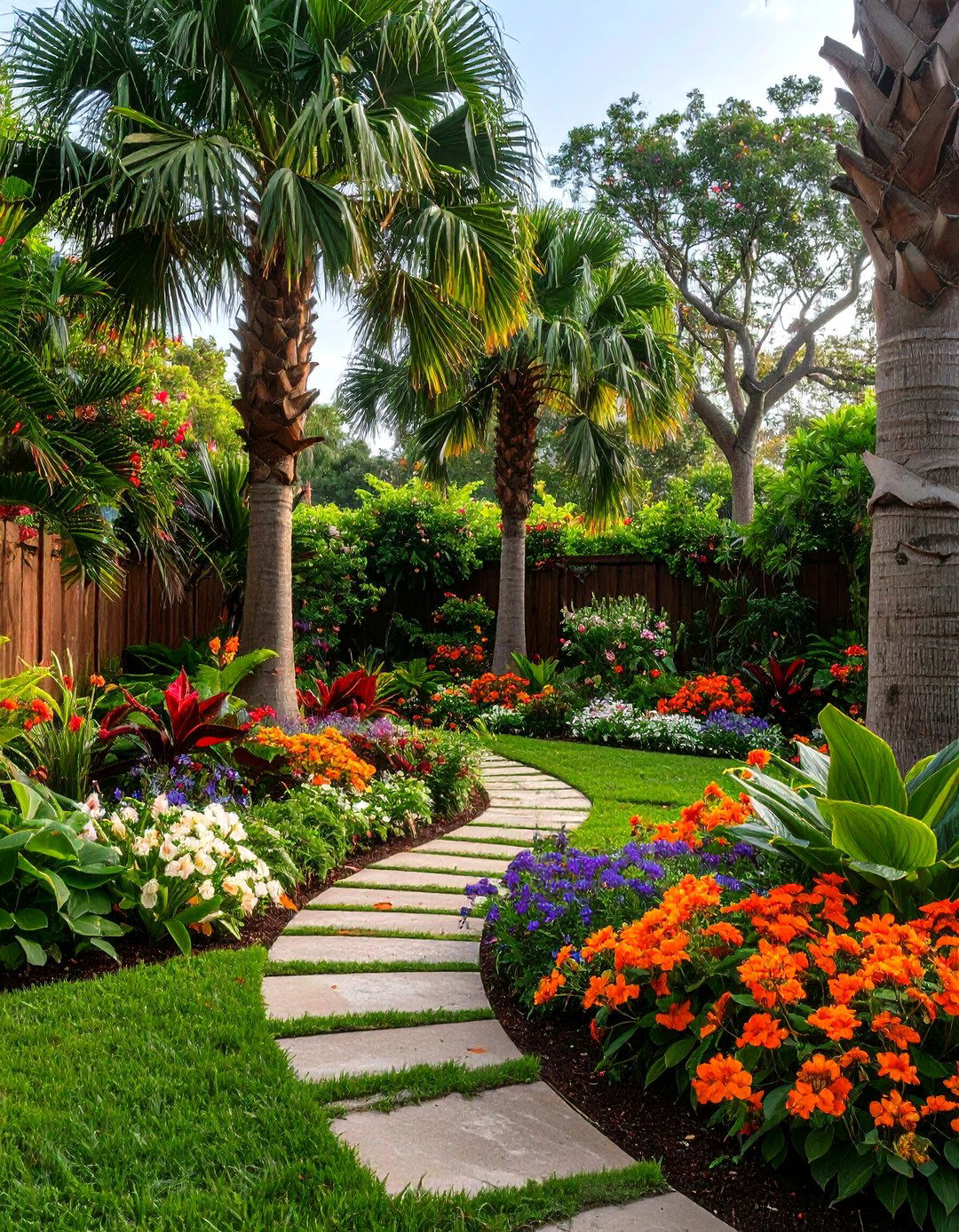
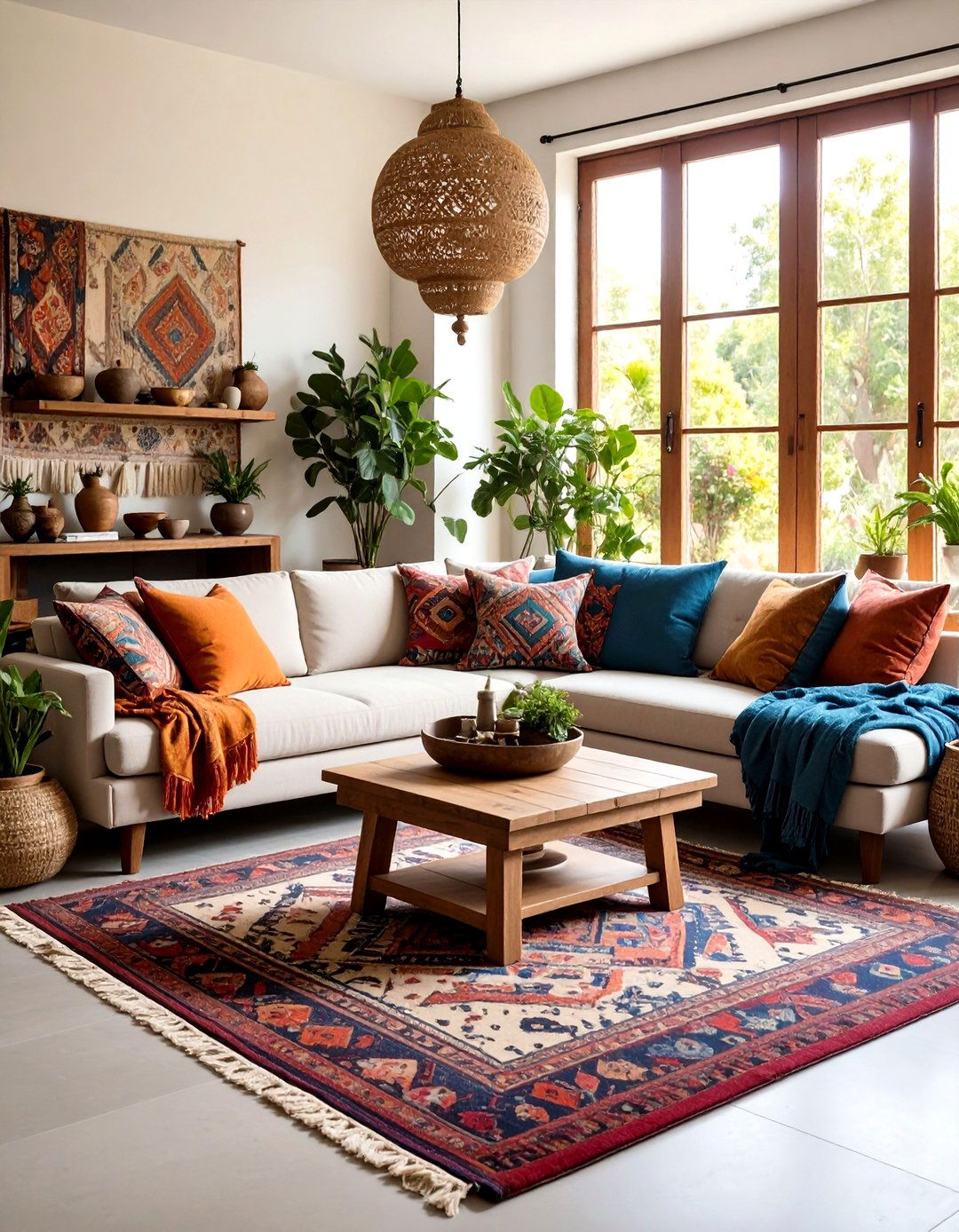


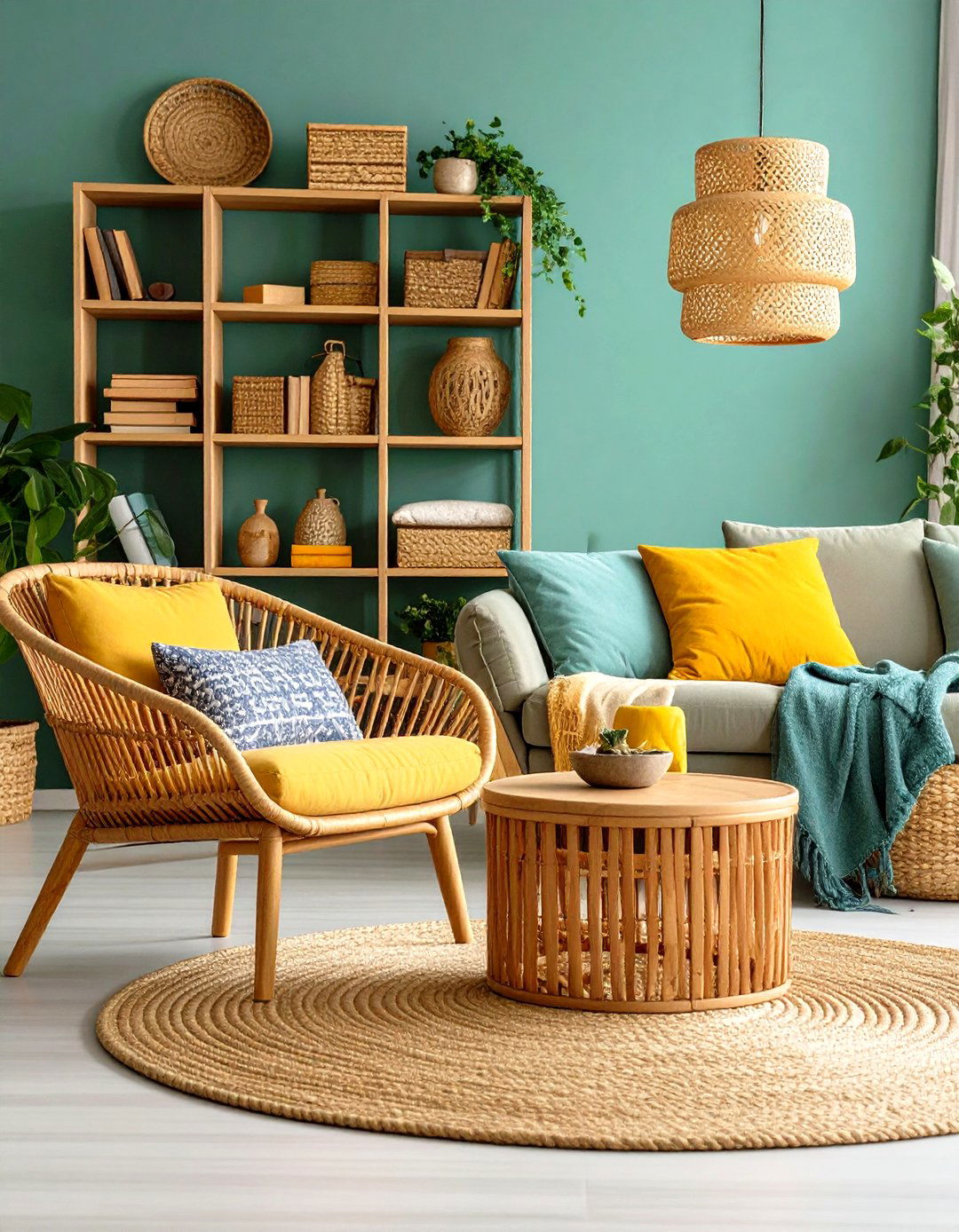
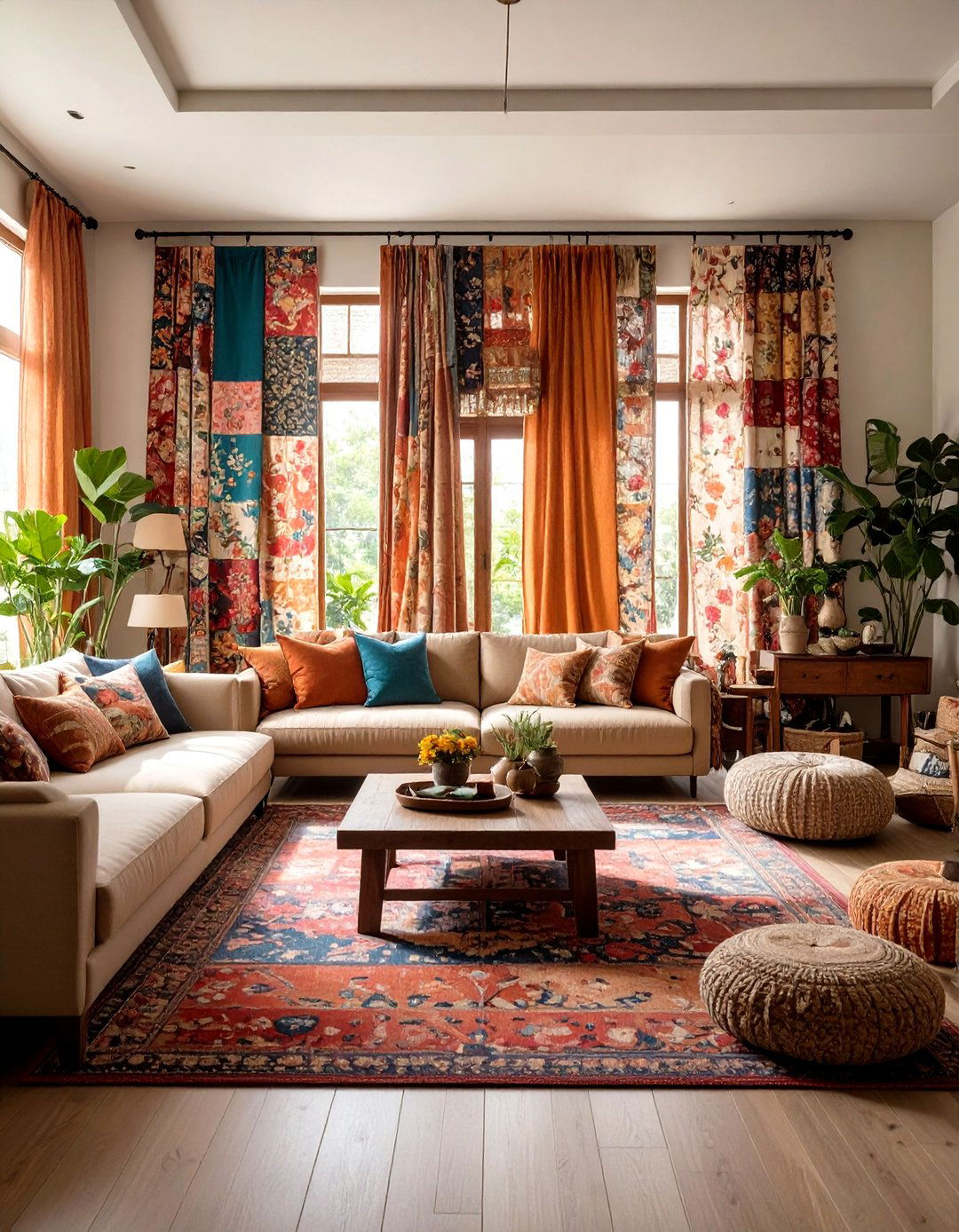
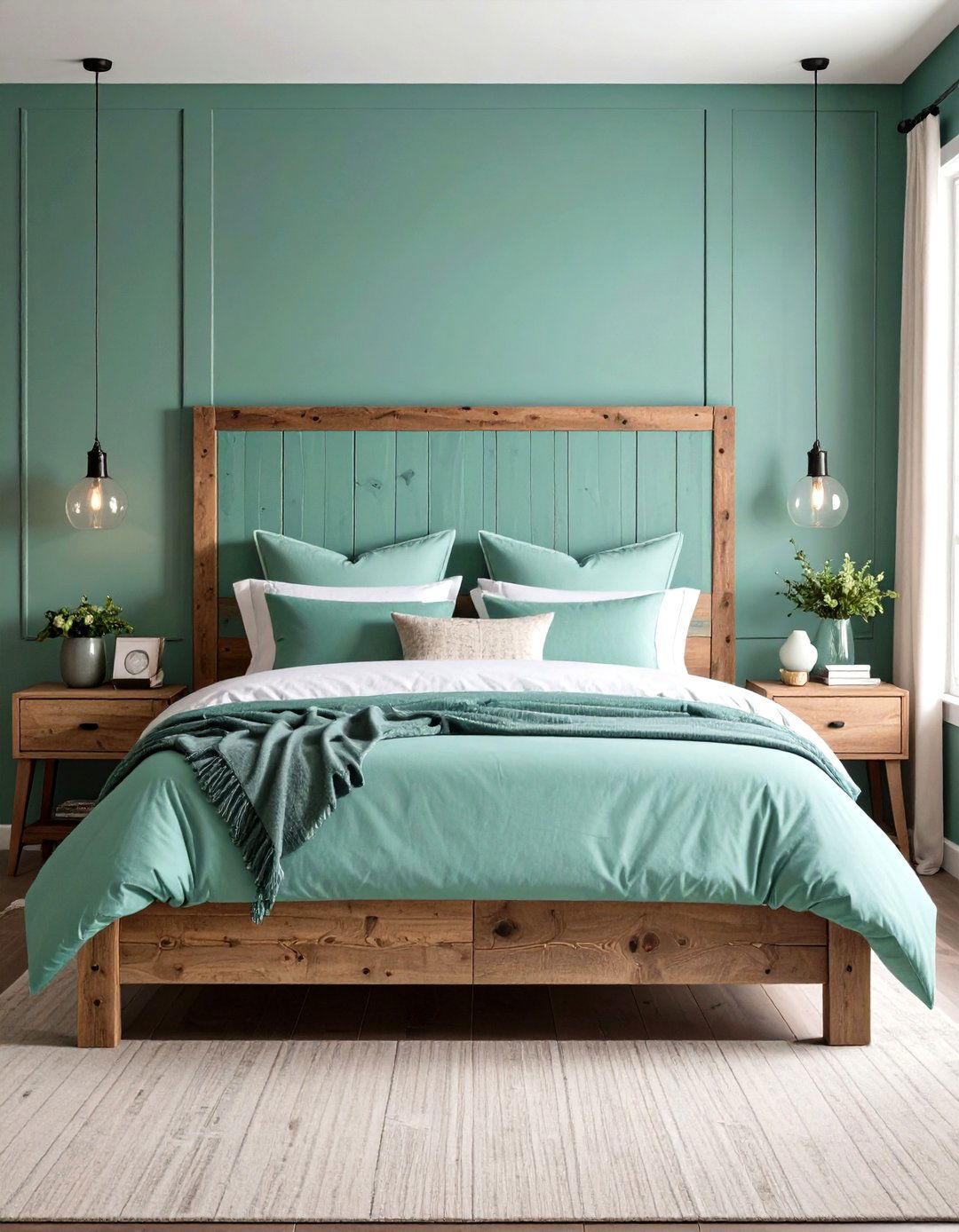

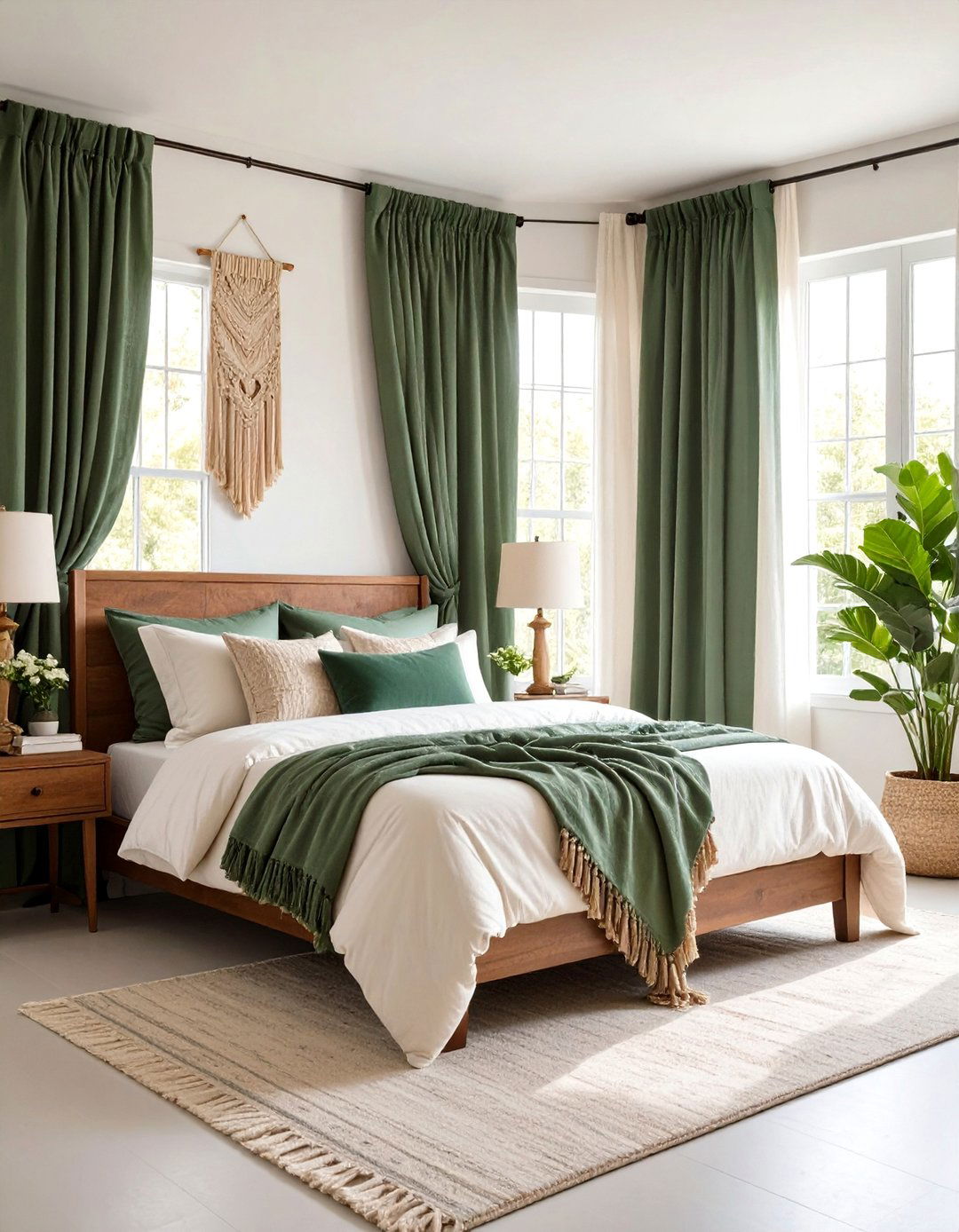

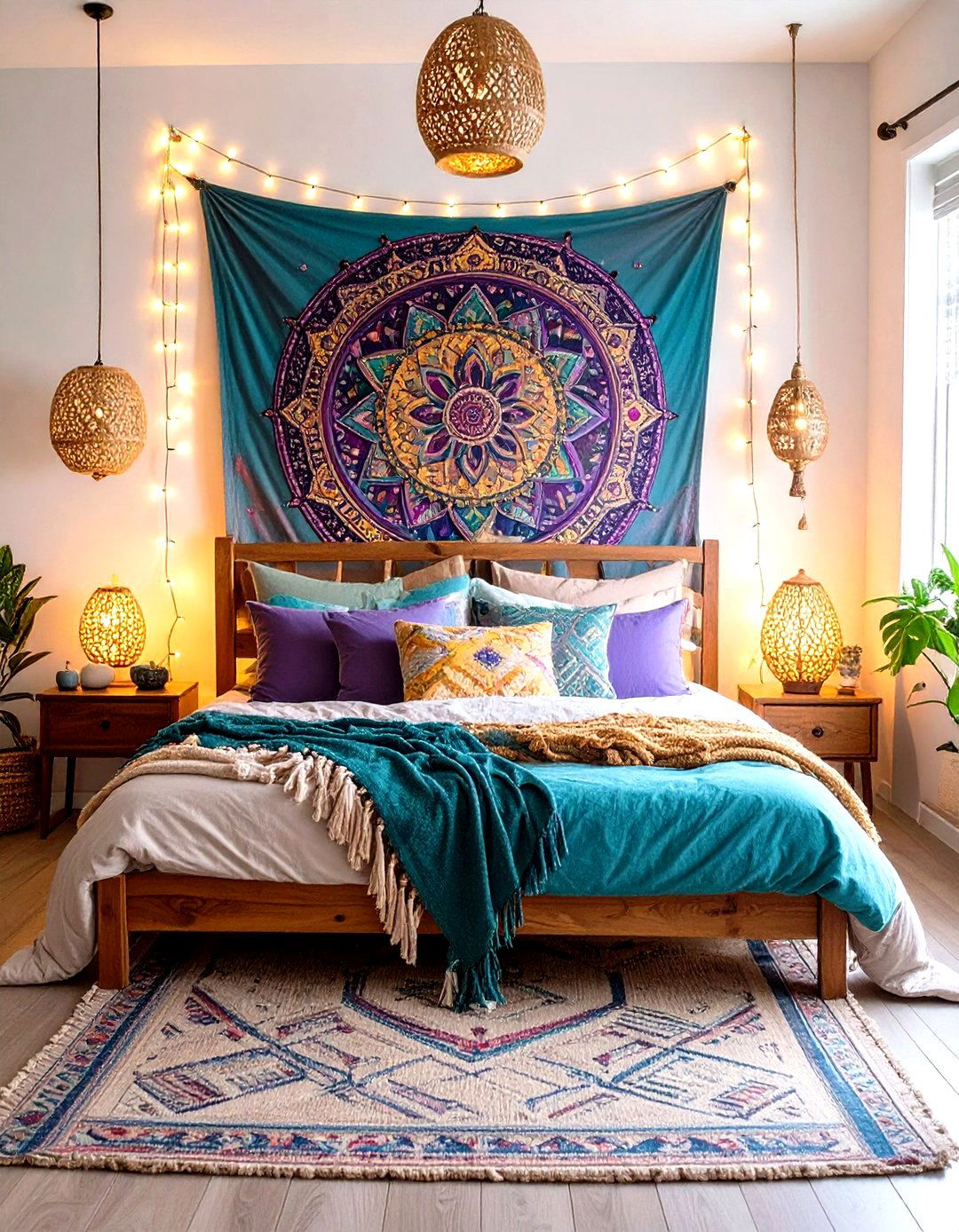
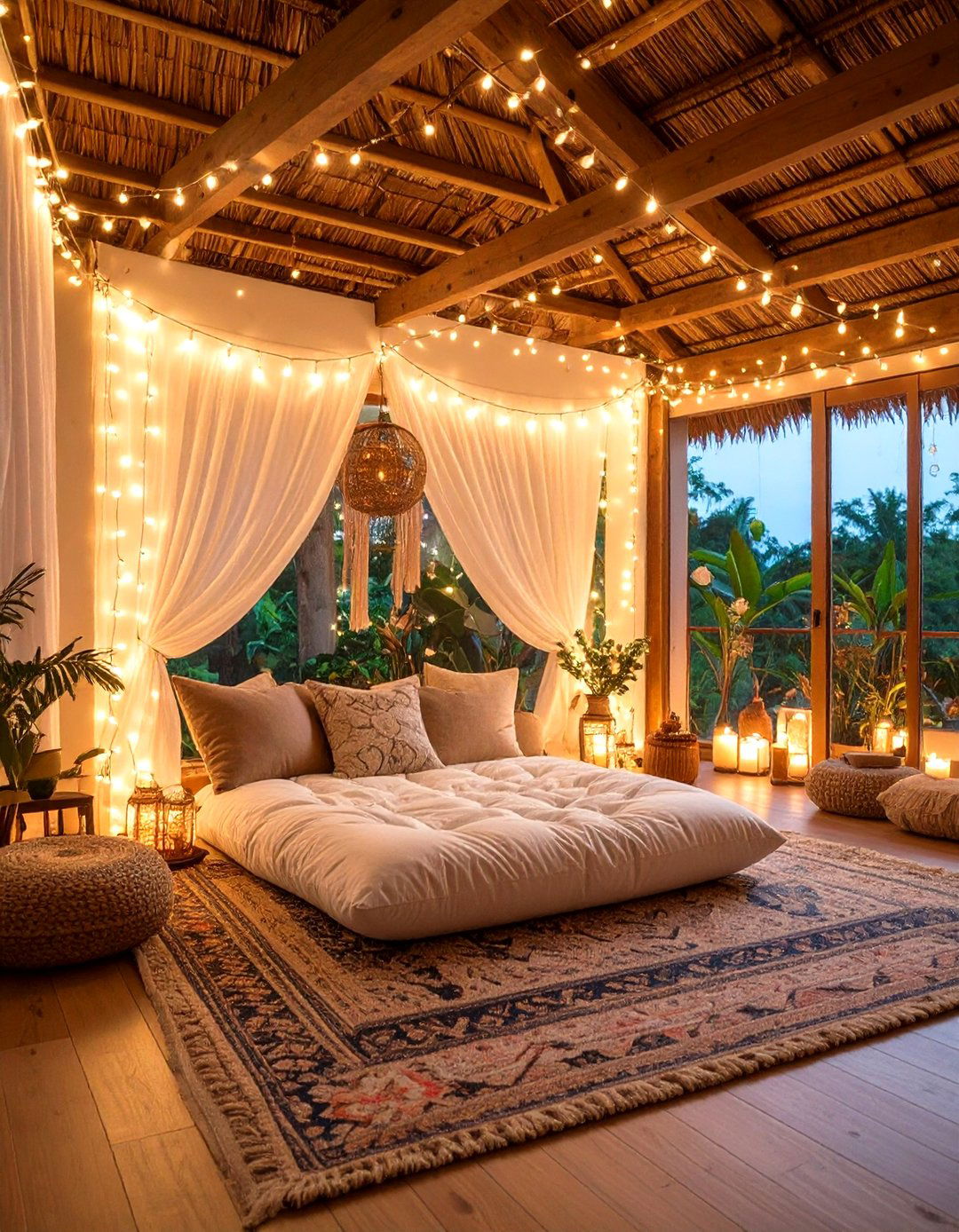
Leave a Reply